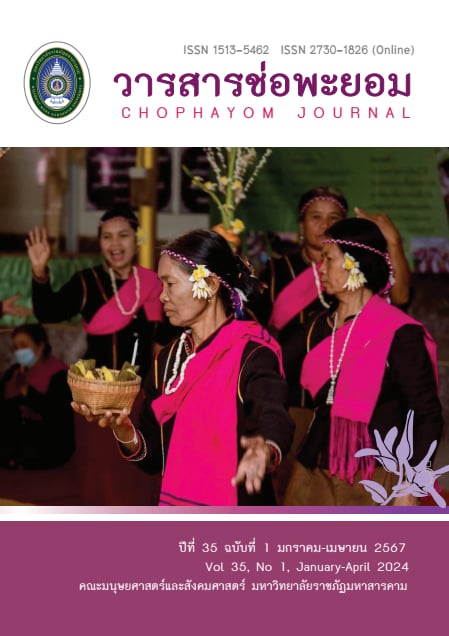ความเป็นองค์กรแห่งความสุขในสถานศึกษา สังกัดสำนักงานเขตพื้นที่การศึกษามัธยมศึกษากรุงเทพมหานคร เขต 1
คำสำคัญ:
องค์กรแห่งความสุข, ความเป็นองค์กรแห่งความสุขในสถานศึกษา, ความสุขในการทำงานบทคัดย่อ
การศึกษาครั้งนี้เป็นการวิจัยเชิงสำรวจ มีวัตถุประสงค์ เพื่อศึกษาและ เปรียบเทียบความคิดเห็นของครูที่มีต่อความเป็นองค์กรแห่งความสุขในสถานศึกษา สังกัดสำนักงานเขตพื้นที่การศึกษามัธยมศึกษากรุงเทพมหานคร เขต 1 จำแนกตามวิทยฐานะ ประสบการณ์การทำงาน และกลุ่มโรงเรียน กลุ่มตัวอย่างที่ใช้ในการวิจัย คือ ครูในสถานศึกษาสังกัดสำนักงานเขตพื้นที่การศึกษามัธยมศึกษา กรุงเทพมหานคร เขต 1 ปีการศึกษา 2566 โดยใช้วิธีการสุ่มตัวอย่างแบบแบ่งชั้นภูมิ โดยอาศัยตารางสำเร็จรูปของโคเฮน (Cohen) ได้จำนวน 357 คน เครื่องมือที่ใช้ในการวิจัยเป็นแบบสอบถามแบบมาตราส่วน 5 ระดับ จำนวน 42 ข้อ ที่มีค่าความเที่ยงตรง (IOC) ระหว่าง 0.8-1.00 ค่าอำนาจจำแนกรายข้อทุกข้อมีค่า ตั้งแต่ 0.20 ขึ้นไป และค่าความเชื่อมั่นด้วยการหาค่าสัมประสิทธิ์แอลฟ่าของครอนบาค ได้เท่ากับ .977 สถิติที่ใช้ในการวิเคราะห์ คือ การแจกแจงความถี่ ค่าร้อยละ ค่าเฉลี่ย ค่าเบี่ยงเบนมาตรฐาน การทดสอบค่าทีแบบกลุ่มอิสระ (Independent Samples t-test) สำหรับข้อมูลที่จำแนกตามตำแหน่งวิทยฐานะ และการวิเคราะห์ความแปรปรวนทางเดียว (One-way ANOVA) สำหรับข้อมูลที่จำแนกตามประสบการณ์การทำงานและกลุ่มโรงเรียน หากพบว่ามีความแตกต่างกันอย่างมี นัยสำคัญที่ทางสถิติที่ระดับ .05 ให้เปรียบเทียบความแตกต่างกันของคะแนน เฉลี่ยเป็นรายคู่ด้วยวิธีการของเชฟเฟ่ (Scheffe’s post hoc comparisons method)
ผลการวิจัยพบว่า 1) ครูมีความคิดเห็นต่อความเป็นองค์กรแห่งความสุขในสถานศึกษา สังกัดสำนักงานเขตพื้นที่การศึกษามัธยมศึกษากรุงเทพมหานคร เขต 1 โดยภาพรวมและรายด้านอยู่ในระดับมาก และเรียงลำดับตามค่าเฉลี่ยจากมากไปน้อย คือ ด้านรู้รักการเรียนรู้ ด้านมีน้ำใจงาม ด้านมีสังคมที่มีความสุข ด้านมีคุณธรรม ด้านสุขภาพดี ด้านมีครอบครัวดี ด้านใช้เงินเป็น และด้านการผ่อนคลาย 2) ผลการเปรียบเทียบความคิดเห็นของครูที่มีต่อความเป็นองค์กร แห่งความสุขในสถานศึกษา สังกัดสำนักงานเขตพื้นที่การศึกษามัธยมศึกษา กรุงเทพมหานคร เขต 1 มีดังนี้ 2.1 ครูที่มีวิทยฐานะต่างกัน มีความคิดเห็นต่อความเป็นองค์กรแห่งความสุขในสถานศึกษา ตามการรับรู้ของครู สังกัดสำนักงานเขตพื้นที่การศึกษามัธยมศึกษากรุงเทพมหานคร เขต 1 โดยภาพรวมและราย ด้านไม่แตกต่างกัน 2.2 ครูที่มีประสบการณ์การทำงานต่างกัน มีความคิดเห็นต่อความเป็นองค์กรแห่งความสุขในสถานศึกษาตามการรับรู้ของครู สังกัดสำนักงานเขตพื้นที่การศึกษามัธยมศึกษากรุงเทพมหานคร เขต 1 โดยภาพรวมและรายด้านไม่แตกต่างกัน 2.3 ครูที่ปฏิบัติงานในสถานศึกษาต่างกลุ่มโรงเรียนกัน มีความคิดเห็นต่อความเป็นองค์กรแห่งความสุขในสถานศึกษา ตามการรับรู้ของครูสังกัดสำนักงานเขตพื้นที่การศึกษามัธยมศึกษากรุงเทพมหานคร เขต 1 โดยภาพรวม และรายด้านแตกต่างกันอย่างมีนัยสำคัญทางสถิติที่ระดับ .05
คำสำคัญ : องค์กรแห่งความสุข , ความเป็นองค์กรแห่งความสุขในสถานศึกษา, ความสุขในการทำงาน
เอกสารอ้างอิง
จิระภา สมัครพงษ์. (2564). องค์กรแห่งความสุขในสถานศึกษาตามความคิดเห็นของครู สังกัดสำนักงานเขตพื้นที่การศึกษาประถมศึกษาตรัง เขต 1. (สารนิพนธ์ศึกษาศาสตร์มหาบัณฑิต, มหาวิทยาลัยหาดใหญ่).
ชุติมา แหวนนาค และชิณโสณ์ วิสิฐนิธิกิจา. (2564). ความสุขในการทำงานส่งผลต่อประสิทธิภาพการปฏิบัติงานของข้าราชการ สังกัดสถาบันพัฒนาข้าราชการกรุงเทพมหานคร. วารสารวิจัยวิชาการ, 4(4), 157.
ณัฐพันธุ์ มีมุข. (2560). อิทธิพลขององค์กรแห่งความสุขที่ส่งผลต่อความผูกพันในองค์กรของบุคลากร มหาวิทยาลัยรามคำแหง. (วิทยานิพนธ์บริหารธุรกิจมหาบัณฑิต, มหาวิทยาลัยรามคำแหง).
ธวัชชัย แสงแปลง. (2563). รูปแบบภาวะผู้นำใฝ่บริการ เพื่อพัฒนาสถานศึกษาสู่องค์กรแห่งความสุข. (วิทยานิพนธ์ปรัชญาดุษฎีบัณฑิต, มหาวิทยาลัยราชภัฏกำแพงเพชร).
นันท์สินี ทวิสุวรรณ. (2562). สุขภาวะองค์กรของโรงเรียนบ้านเขาอ่างแก้ว. (การศึกษาอิสระปริญญาศึกษาศาสตรมหาบัณฑิต, มหาวิทยาลัยศิลปากร).
พเยาว์ หมอเล็ก. (2560). ขวัญกำลังใจในการปฏิบัติงานของครูสังกัดองค์กร อำเภอเมือง จังหวัดยะลา. (การศึกษาอิสระปริญญาศึกษาศาสตรมหาบัณฑิต, มหาวิทยาลัยราชภัฏยะลา).
พัชรพรรณ เวียงเก่า. (2561). ความสัมพันธ์ระหว่างภาวะผู้นำการเปลี่ยนแปลงของหัวหน้าหอผู้ป่วยกับการเป็นองค์กรแห่งความสุข กลุ่มการพยาบาลโรงพยาบาลแพร่. (วิทยานิพนธ์พยาบาลศาสตรมหาบัณฑิต, มหาวิทยาลัยมหาวิทยาลัยนเรศวร).
ฤติมา บุญบำรุง. (2560). ความสุขในการทำงานของข้าราชการครู สังกัดสำนักงานเขตพื้นที่การศึกษาประถมศึกษาชลบุรี เขต 3 อำเภอสัตหีบ. (งานนิพนธ์ปริญญาการศึกษามหาบัณฑิต, มหาวิทยาลัยบูรพา).
วัลลภ บุตรเกตุ และสำเริง อ่อนสัมพันธุ์. (2563). วัฒนธรรมองค์การกับความสุขในการทำงานของครูในโรงเรียน สังกัดสำนักงานเขตพื้นที่การศึกษามัธยมศึกษา เขต9. ศิลปการจัดการ, 4(3), 747-753.
วรรณวัฏ ณ พัทลุง. (2565). การเป็นองค์กรแห่งความสุขของโรงเรียนขนาดใหญ่พิเศษ สังกัดสำนักงาน เขตพื้นที่การศึกษามัธยมศึกษาสงขลา สตูล. (สารนิพนธ์ปริญญาศึกษาศาสตร์มหาบัณฑิต, มหาวิทยาลัยหาดใหญ่).
สิทธิเดช เสมอภักดิ์ และศิริพงษ์ เศาภายน. (2566). องค์กรแห่งความสุข (Happiness Workplace) ตามทัศนะของครู สังกัดสำนักงานเขตพื้นที่การศึกษามัธยมศึกษากรุงเทพมหานคร เขต 2. มจร อุบลปริทรรศน์. 8 (2), 2.
สุพรรณศรี พันธ์แตง. (2565). ภาวะผู้นำใฝ่บริการของผู้บริหารสถานศึกษาที่ส่งผลต่อการสร้างองค์กรแห่งความสุขในโรงเรียน สังกัดสำนักงานเขตพื้นที่การศึกษามัธยมศึกษาสุพรรณบุรี. (วิทยานิพนธ์ปริญญาครุศาสตรมหาบัณฑิต, มหาวิทยาลัยราชภัฏนครปฐม).
สำนักงานกองทุนสนับสนุนการสร้างเสริมสุขภาพ. (2552). รายงานประจำปี 2552 กองทุนสนับสนุนการ สร้างเสริมสุขภาพ (สสส.). กรุงเทพฯ: สำนักงานกองทุนสนับสนุนการสร้างเสริมสุขภาพ.
สำนักงานคณะกรรมการพัฒนาการเศรษฐกิจและสังคมแห่งชาติ. (2560). แผนพัฒนาเศรษฐกิจและ สังคมแห่งชาติ ฉบับที่ 13 (พ.ศ. 2566-2570). กรุงเทพฯ: สำนักงานคณะกรรมการพัฒนาการเศรษฐกิจและสังคมแห่งชาติ.
Burton, J. (2010). WHO Healthy Workplace Framework and Model : Background and Supporting Literature and Practice : Word Health Organization. Retrieved 18 May 2023, from www.who.int/occupational_health/healthy_workplace_framework.pdf.
Gray, R. (2007). A Climate of Success. Oxford, United Kingdom: Butterworth-Heinemann.
ดาวน์โหลด
เผยแพร่แล้ว
รูปแบบการอ้างอิง
ฉบับ
ประเภทบทความ
สัญญาอนุญาต
ลิขสิทธิ์ (c) 2024 วารสารช่อพะยอม

อนุญาตภายใต้เงื่อนไข Creative Commons Attribution-NonCommercial-NoDerivatives 4.0 International License.






